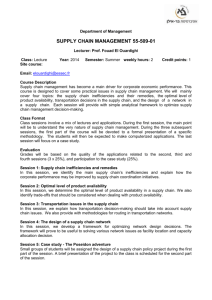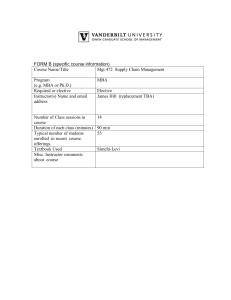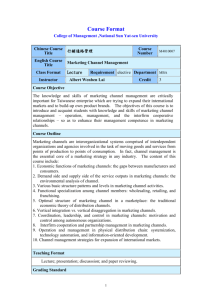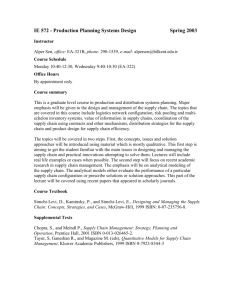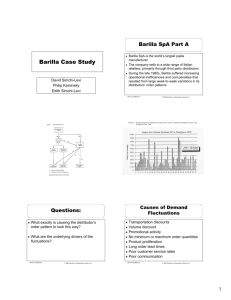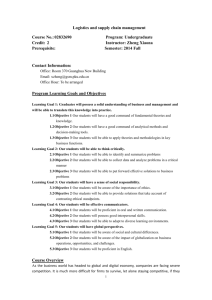International Logistics
advertisement
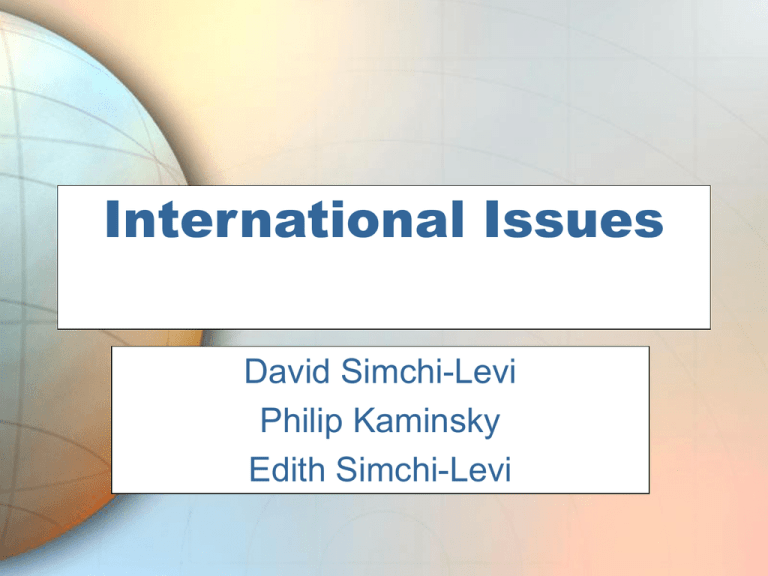
International Issues Phil Simchi-Levi Kaminsky David kaminsky@ieor.berkeley.edu Philip Kaminsky Edith Simchi-Levi Wal-Mart in South America Why is Wal-Mart not as successful in Latin America as they are in the US? What mistakes did Wal-Mart make? If you were running Wal-Mart, what would you have done differently? McGraw-Hill/Irwin © 2003 Simchi-Levi, Kaminsky, Simchi-Levi Wal-Mart in South America Product differences – Are there global products? – Is this a trend? – What is the balance between local tastes, global products? Dealing with established competition, aggressive competitors Developing market knowledge McGraw-Hill/Irwin © 2003 Simchi-Levi, Kaminsky, Simchi-Levi Wal-Mart in South America Lack of critical mass Different infrastructure/ business environment – distribution problems – different equipment standards cultural differences – postdated checks Issues with foreign governments Deep pockets for success McGraw-Hill/Irwin © 2003 Simchi-Levi, Kaminsky, Simchi-Levi Taxonomy of International Supply Chains What are some advantages, disadvantages of: – International distribution – International suppliers – Off-shore manufacturing – Fully integrated global supply chain McGraw-Hill/Irwin © 2003 Simchi-Levi, Kaminsky, Simchi-Levi Increasing Globalization 1/5 of output of US firms produced abroad US Companies hold $500 Billion in foreign asset stocks (7% annual growth) 1/4 of US imports between foreign affiliates and US parent companies Over half of US companies increased the number of countries in which they operate (late 80’s to early 90’s) McGraw-Hill/Irwin © 2003 Simchi-Levi, Kaminsky, Simchi-Levi Forces Driving Globalization Global Market Forces Technological Forces Global Cost Forces Political and Economic Forces McGraw-Hill/Irwin © 2003 Simchi-Levi, Kaminsky, Simchi-Levi Global Market Forces Foreign competition in local markets Growth in foreign demand – Domestic consumption from 40% to <30% of world consumption since 1970 – Foreign sales fuel growth Global presence as a defensive tool – Nestle’s and Kellogg’s Presence in state-of-the-art markets – Japan -- consumer electronics – Germany -- machine tools – US: SUV’s McGraw-Hill/Irwin © 2003 Simchi-Levi, Kaminsky, Simchi-Levi Technological Forces Diffusion of knowledge – Many high tech components developed overseas – Need close relationships with foreign suppliers – For example, Canon has 80% of laser engines Technology sharing/collaborations – Access to technology/markets Global location of R&D facilities – Close to production (as cycles get shorter) – Close to expertise (Indian programmers?) McGraw-Hill/Irwin © 2003 Simchi-Levi, Kaminsky, Simchi-Levi Global Cost Forces Low labor cost – Diminishing importance (Costs underestimated, benefits overestimated) Other cost priorities – Integrated supplier infrastructure (as suppliers become more involved in design) – Skilled labor Capital intensive facilities – – – – tax breaks joint ventures price breaks cost sharing McGraw-Hill/Irwin © 2003 Simchi-Levi, Kaminsky, Simchi-Levi Political and Economic Forces Exchange rate fluctuations and operating flexibility Regional trade agreements (Europe, North America, Pacific Rim) – Value of being in a country in one of these regions – Implications for supply network design – Reevaluation of foreign facilities (Production processes designed to avoid tariffs) McGraw-Hill/Irwin © 2003 Simchi-Levi, Kaminsky, Simchi-Levi Political and Economic Forces Trade protection mechanisms – Tariffs – Quotas – Voluntary export restrictions Japanese automakers in US – Local content requirements TI/Intel factories in Europe Japanese automakers in the EU – Health/environmental regulations Japanese refused to import US skis for many years (different snow) – Government procurement policies Up to 50% advantage for American companies on US Defense contracts McGraw-Hill/Irwin © 2003 Simchi-Levi, Kaminsky, Simchi-Levi Added Complexities Substantial geographic distances Added forecasting difficulties Infrastructural Inadequacies – Worker skill, performance expectations – Supplier availability, reliability, contracts – Lack of local technologies – Inadequacies in transportation, communications infrastructure McGraw-Hill/Irwin © 2003 Simchi-Levi, Kaminsky, Simchi-Levi Added Complexities Exchange rate uncertainties Cultural differences – accepted partnerships, styles – value of punctuality Political instability – tax rates – government control Added competition “at home” McGraw-Hill/Irwin © 2003 Simchi-Levi, Kaminsky, Simchi-Levi Additional Issues In Global SCM Regional vs. International Products – Cars vs. Coca-cola Local Autonomy vs. Central Control – SmithKline introducing Contact to Japan – Short term expectations Collaborators become competitors – China – Toshiba copiers, Hitachi microprocessors McGraw-Hill/Irwin © 2003 Simchi-Levi, Kaminsky, Simchi-Levi Case Summary: Pizza Hut Moscow Moscow - May 1991 Two Pizza Huts to open in Moscow -- “Toe in the water for Western business” Pizza Hut - 49% partner in joint venture Key Issue: Foreign companies cannot repatriate their earnings (ruble earnings could not be converted to hard currencies) How was this addressed? McGraw-Hill/Irwin © 2003 Simchi-Levi, Kaminsky, Simchi-Levi Pizza Hut Moscow What issues did Pizza Hut face before starting operation? How were these issues addressed? What issues appeared after the restaurant opened? How should these be addressed? McGraw-Hill/Irwin © 2003 Simchi-Levi, Kaminsky, Simchi-Levi Case Summary: Pizza Hut Moscow Difficulties – Communication was difficult – Different concepts of restaurants Hygiene days vs. routine hygiene – Construction difficult due to lack of supplies Even nuts and bolts needed to be imported – Difficult to get suppliers 70% USSR sourcing desired to ensure long-term viability Difficulty with winter shortages Mozzarella unavailable – Couldn’t be made due to poor quality cows – Cows had to be raised differently McGraw-Hill/Irwin © 2003 Simchi-Levi, Kaminsky, Simchi-Levi Case Summary: Pizza Hut Moscow Difficulties – Quality, reliability unavailable from meat plants – Refrigerated trucks unavailable Two restaurants set up: ruble restaurant and hard currency restaurant – Hard currency restaurant more expensive for same items, better service – Hedge against exchange rate risk, get hard currency Human Resources – – – – Extremely well educated staff Unfamiliar with western concepts of quality Incentive systems critical Two separate staffs - more qualified in hard currency restaurant Catalog for tips McGraw-Hill/Irwin © 2003 Simchi-Levi, Kaminsky, Simchi-Levi Case Summary: Pizza Hut Moscow Initial operations – Government randomly shut down the facilities several times – Prices changed rapidly and without warning – Even with relatively low employee turnover -- one new employee a day – Incentive programs didn’t work Program started with bonus, decreased if goals not met Salary floor was higher than typical salary – Difficult to establish team ethic – Absenteeism a problem – Soviet (2 day on, 2 day off) schedule hard to work with McGraw-Hill/Irwin © 2003 Simchi-Levi, Kaminsky, Simchi-Levi Exchange Rates Transaction Exposure – The results of transactions denominated in foreign currencies change (cash deposits, debt obligations) Translation Exposure – Result of translating foreign financial statements into the currency of the parent company Financial instruments used to hedge these McGraw-Hill/Irwin © 2003 Simchi-Levi, Kaminsky, Simchi-Levi Operating Exposure Changes a firm’s competitive position and future cash flows In the short run, changes in currency rates don’t necessarily reflect changes in inflation rates Regional operations become relatively more or less expensive McGraw-Hill/Irwin © 2003 Simchi-Levi, Kaminsky, Simchi-Levi Effect of Operating Exposure Depends on – Customer reactions – Competitor reactions market share profit – Supplier reactions – Government reaction McGraw-Hill/Irwin © 2003 Simchi-Levi, Kaminsky, Simchi-Levi Examples Company which manufactures and sells exclusively domestically Company which imports and sells domestically Company which manufactures and sells globally McGraw-Hill/Irwin © 2003 Simchi-Levi, Kaminsky, Simchi-Levi Operational Strategies To Address These Risks Speculative Strategy – Bet on a single scenario – Japanese auto manufacturing in Japan Hedged Strategy – Losses in one area offset by gains in another – VW in US, Brazil, Mexico, Germany Flexible Strategy McGraw-Hill/Irwin © 2003 Simchi-Levi, Kaminsky, Simchi-Levi Operational Flexibility Flexibility to take advantages of operational exposure Requires a flexible supply chain – – – – multiple suppliers flexible facilities excess capacity various distribution channels Can be expensive to implement – coordination mechanisms – capital investments – loss of economies of scale McGraw-Hill/Irwin © 2003 Simchi-Levi, Kaminsky, Simchi-Levi Operational Flexibility Production/sourcing shifts are key to strategy – This has many switching/startup costs Distribution channels must be flexibility so sourcing is invisible to end customers Other benefits include: – improved information availability – global coordination – political leverage McGraw-Hill/Irwin © 2003 Simchi-Levi, Kaminsky, Simchi-Levi Example Becton Dickinson – Global network for manufacturing disposable syringes – Plants in US, Ireland, Mexico, Brazil – When Peso devalued, shifted production to Mexico McGraw-Hill/Irwin © 2003 Simchi-Levi, Kaminsky, Simchi-Levi Case Summary: BMW -- Globalizing Manufacturing Operations 1994 - Majority of BMW manufacturing in Germany – Some “kit factories” in Far East Disappointing market share in 1994 US Problems – – – – 1986-1989 Sales in US fell 65% Gas guzzler tax Luxury tax Japanese Competition Dramatically Cheaper McGraw-Hill/Irwin © 2003 Simchi-Levi, Kaminsky, Simchi-Levi Case Summary: BMW -- Globalizing Manufacturing Operations US Problems, Continued – High German labor costs 45% Higher than US Longer vacations Higher Absenteeism – Appreciating mark – Production costs in Germany 30% Higher than US Solution - US Plant – Enables operational flexibility McGraw-Hill/Irwin © 2003 Simchi-Levi, Kaminsky, Simchi-Levi Case Summary: BMW -- Globalizing Manufacturing Operations Additional Issues – Tax breaks in South Carolina – Opportunity to build new, flexible plant New labor practices New culture New technology – To ensure quality, much training Building a Global Supplier Network – Local supplier base key to success (NAFTA, transportation) – Requires careful selection, training – Value of local suppliers vs. firms which could supply all BMW plants McGraw-Hill/Irwin © 2003 Simchi-Levi, Kaminsky, Simchi-Levi
